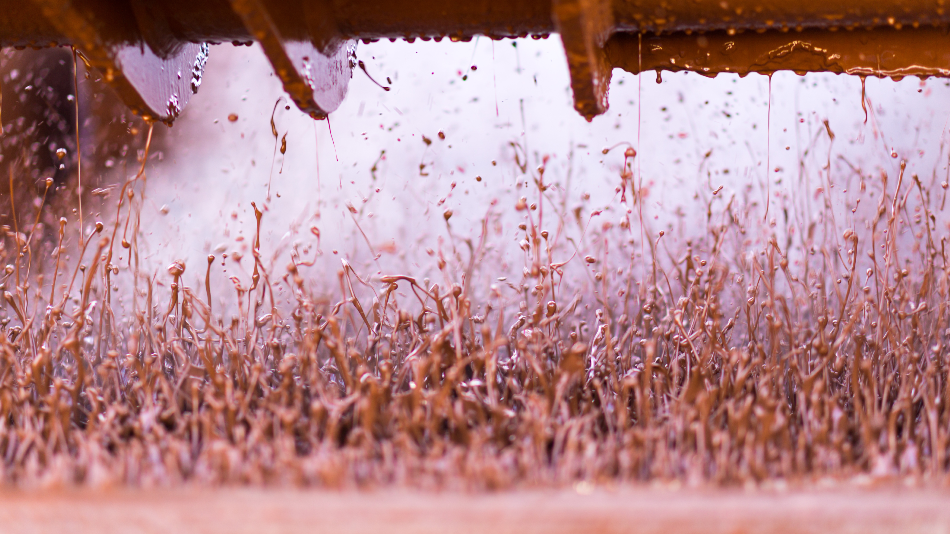Article updated on 26 August 2021

Image Credit: W.Kilany/Shutterstock.com
Drilling is a key process within the oil and gas industry, especially in the upstream phase where several stages such as exploration, drilling, production, and improved oil recovery, are all to be accomplished sequentially. As the drills bite down through thick layers of rock, it heats up. The drilling fluid cools it down also causing lubrication. Simultaneously, the cutting is washed away and the formation is preserved while permeable formation is kept off.
A common drilling fluid used in this context is water-based mud (WBM). However, this material must operate in an environment of high temperature and high pressure (HTHP) at which point fluid properties deteriorate considerably. The addition of nanofluids to this fluid could alter its rheological characteristics, increasing the success of the drilling operation. Since drilling fluid also contributes to the cost of the whole process, cutting down fluid losses is an important achievement for cutting costs as well.
Nanofluids are any fluids that contain at least one additive whose particle size is 1-100 nm, making them smaller than microparticles, with a uniquely high ratio of surface to volume. This accounts for many of their properties.
Rheology
Rheology refers to how materials flow and deform under standardized conditions. The flow of materials is seen with materials that resemble liquids, while those which are more like solids show deformation. Rheology can, therefore, define the behavior of viscoelastic and complex materials that have features of both solids and liquids. It is also among the most crucial determinants of the performance of a drilling fluid, which in turn is responsible for a host of drilling issues, including loss circulation, damage to the formation of pipe sticking.
A typical drilling fluid acts as a non-Newtonian fluid, showing pseudoplastic or shear-thinning behavior, where the fluid viscosity is inversely proportional to the degree of shear. To determine its rheological nature, a rheometer is used to carry out rheological tests. However, unless both viscous and elastic features of the drilling fluid are studied in addition to its rheology, a near-ideal drilling fluid is difficult to achieve. Another important aspect is thixotropy, a property that determines how quickly a drilling fluid becomes gel-like, thus preventing the sedimentation of heavy particles.
Modified Drilling Fluid Containing Nanoparticles
The addition of nanoparticles to drilling fluid can improve its rheology. One study has shown that adding graphite and silicon dioxide at very low concentrations, below 0.14%, keeps the fluid closely similar in behavior to the untreated drilling fluid concerning flow, following the Herschel Bulkley model, but with a somewhat higher viscosity. This is because nanoparticles can disperse more evenly over the surface of the bentonite.
Elasticity
The treated fluid was, however, observed to have a greater elasticity within a linear viscoelastic range, but when reached flow point, the shear stress was lower. The nanoparticles gave a better gel structure, enabling it to break up without high shear stress.
Increasing the concentration of nanoparticles allows the fluid to become more elastic, and this minimizes the sedimentation of the cuttings and other materials. A high degree of sedimentation adversely affects drilling, since it causes high plastic viscosity, reducing the strength of the gel, and reducing the yield point.
With the addition of nanoparticles at optimum concentrations, the fluid is then able to regain its structure more rapidly and to a greater degree as the rebuild time is cut drastically.
Stability under high temperature, high-pressure conditions
Another study where 1% copper and zinc oxide nanoparticles in xanthan gum were added to the WBM at varying temperatures, from 25 0C to 110 0C, the rheology changed for the better with the pressure in proportion to the temperature, making the fluid more stable for its viscosity at higher temperatures.
The addition of certain specialized clay nanoparticles to drilling fluid also changes the rheology for the better, besides making it possible to control various properties such as shear thinning, therefore reducing formation damage. The authors report the plastic viscosity and yield point of the modified fluid, concluding that the addition of the clay nanoparticles lends stability under HTPT conditions.
Conclusion
The addition of nanoparticles to create a modified drilling fluid imparts improvement in thixotropy and viscoelasticity, while preserving a flow similar to that of the native fluid. The degree and kind of enhancement in rheological properties are dependent on the type and concentration of the nanoparticles added.
References and Further Reading
Enhancement of drilling fluid rheology by nanoparticles. Mortatha Alyasiri, Joseph Antony, and Dongsheng Wen. Annual Transactions of the Nordic Rheology Society, vol. 25, 2017. https://nrs.blob.core.windows.net/pdfs/nrspdf-1b4d6c9d-5254-4024-9343-6add03f7f1ee.pdf
Effect of CuO and ZnO nanofluids in xanthan gum on thermal, electrical and high-pressure rheology of water-based drilling fluids. Jay Karen Maria William, Swaminathan Ponmani, Robello Samuel, R. Nagarajan, and Jitendra S. Sangwa. Journal of Petroleum Science and Engineering, volume 117, May 2014, pages 15-27. https://doi.org/10.1016/j.petrol.2014.03.005. https://www.sciencedirect.com/science/article/abs/pii/S0920410514000667
Clay nanoparticles modified drilling fluids for drilling of deep hydrocarbon wells. J. Abdo, M.D. Haneef. Applied Clay Science 86 ?(2013) 76-82. http://dx.doi.org/10.1016/j.clay.2013.10.017. https://www.researchgate.net/profile/Jamil_Abdo/publication/285525863_Applied_Clay_Science_paper_published_paper_1-s20-S0169131713003475-main/links/565ed60708aeafc2aac91c8d.pdf
Disclaimer: The views expressed here are those of the author expressed in their private capacity and do not necessarily represent the views of AZoM.com Limited T/A AZoNetwork the owner and operator of this website. This disclaimer forms part of the Terms and conditions of use of this website.